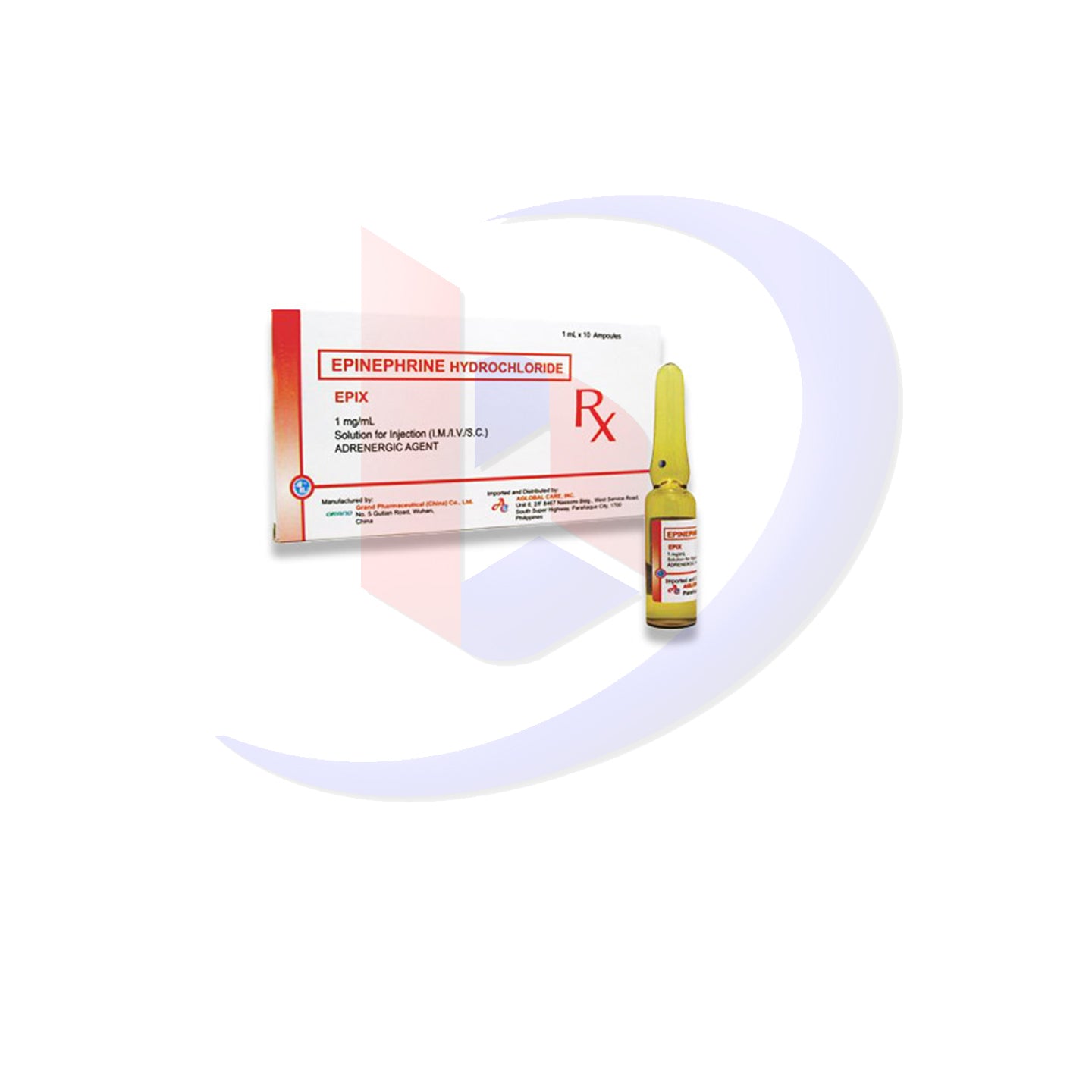Bambang Pharmaceutical Depot Inc.
Epinephrine (Epix) 1mg/ml Solution for Injection I.M/I.V/S.C 1ml x Ampoule 10's
Epinephrine (Epix) 1mg/ml Solution for Injection I.M/I.V/S.C 1ml x Ampoule 10's
Couldn't load pickup availability
Here’s a detailed overview of Epinephrine (Epix) 1mg/ml Solution for Injection (IM/IV/SC) 1ml x Ampoule 10's:
Product Description:
Epinephrine (Epix) 1mg/ml is a solution for injection containing epinephrine (adrenaline), a potent sympathomimetic drug. It is available in 1ml ampoules, with each ampoule containing 1mg of epinephrine per ml. Epinephrine is a naturally occurring hormone and neurotransmitter, primarily produced by the adrenal glands. It plays a critical role in the body’s fight-or-flight response, causing a range of physiological effects including increased heart rate, improved blood flow to muscles, and dilation of the airways.
This formulation is used in emergency medical situations, especially in life-threatening conditions such as severe allergic reactions (anaphylaxis) or cardiac arrest.
Indications:
Epinephrine (Epix) 1mg/ml Solution for Injection is primarily used in emergency settings for the following conditions:
-
Anaphylaxis:
-
Epinephrine is the first-line treatment for severe allergic reactions or anaphylaxis, which may be caused by insect stings, food allergies, or drug reactions. It rapidly reverses the life-threatening symptoms such as airway constriction and hypotension.
-
-
Cardiac Arrest:
-
Epinephrine is used in cardiopulmonary resuscitation (CPR) for the treatment of cardiac arrest, improving heart function and increasing the chances of restoring a normal heart rhythm.
-
-
Severe Asthma Attacks:
-
Epinephrine may be administered in patients experiencing severe asthma attacks that are unresponsive to other bronchodilators.
-
-
Hypotension:
-
In cases of severe hypotension or shock, epinephrine can be used to increase blood pressure and improve circulation.
-
-
Croup in Children:
-
In children, epinephrine is sometimes used in the treatment of croup, a condition that causes airway swelling and difficulty breathing.
-
Dosages and Administration:
Epinephrine (Epix) 1mg/ml Solution for Injection is administered intramuscularly (IM), intravenously (IV), or subcutaneously (SC), depending on the clinical situation. The following are general dosage guidelines:
For Anaphylaxis:
-
Adults:
-
0.3–0.5 mg administered IM or SC every 5-10 minutes as needed, depending on the severity of the reaction.
-
-
Children:
-
0.01 mg/kg body weight up to a maximum dose of 0.3 mg administered IM or SC every 5-10 minutes if required.
-
For Cardiac Arrest:
-
Adults:
-
1 mg IV every 3-5 minutes during cardiac arrest until return of spontaneous circulation or advanced cardiac life support is provided.
-
For Severe Asthma or Bronchospasm:
-
Adults and Children:
-
0.3–0.5 mg IM as a one-time dose, repeatable every 20 minutes if necessary.
-
For Hypotension or Shock:
-
Adults:
-
IV infusion of 0.1-0.5 mcg/kg/min to restore blood pressure, titrating based on clinical response.
-
Side Effects:
Epinephrine is generally well tolerated when used as directed, but it may cause several side effects, especially if overused or improperly administered. Common side effects include:
Common Side Effects:
-
Increased heart rate (tachycardia)
-
Elevated blood pressure (hypertension)
-
Anxiety or restlessness
-
Tremors or shaking
-
Headache
-
Dizziness
-
Nausea and vomiting
Serious Side Effects (Seek immediate medical attention if these occur):
-
Severe chest pain (angina) or heart attack symptoms (especially in patients with pre-existing heart disease)
-
Arrhythmias (irregular heartbeat)
-
Pulmonary edema (fluid in the lungs)
-
Severe allergic reactions (though rare, epinephrine can sometimes induce an allergic reaction in sensitive individuals)
-
Severe hypertension leading to stroke or organ damage
Contraindications:
Epinephrine should not be used in certain conditions or should be used with extreme caution. The following are contraindications and conditions requiring caution:
-
Hypersensitivity to Epinephrine:
-
Contraindicated in patients who are known to have an allergy or hypersensitivity to epinephrine.
-
-
Narrow-Angle Glaucoma:
-
Epinephrine should not be used in individuals with narrow-angle glaucoma, as it may increase intraocular pressure.
-
-
Shock due to non-anaphylactic causes:
-
Epinephrine should be used with caution in patients with non-anaphylactic shock, as it may worsen the condition.
-
-
Severe Hypertension:
-
Caution should be exercised in patients with severe hypertension, as epinephrine may further elevate blood pressure.
-
-
Coronary Artery Disease:
-
Patients with coronary artery disease, heart rhythm disorders, or myocardial ischemia should use epinephrine only under strict medical supervision, as it may worsen these conditions.
-
-
Hyperthyroidism:
-
Epinephrine should be used with caution in patients with hyperthyroidism, as it can exacerbate symptoms like tachycardia or arrhythmias.
-
-
Pregnancy:
-
Epinephrine is a Category C drug during pregnancy, meaning it may pose risks to the fetus. It should only be used if the potential benefits outweigh the risks, especially in life-threatening situations like anaphylaxis.
-
-
Pheochromocytoma:
-
Epinephrine should be used with extreme caution in patients with pheochromocytoma, a tumor of the adrenal glands, as it may trigger a hypertensive crisis.
-
Precautions:
-
Monitoring:
-
Close monitoring of vital signs, including heart rate and blood pressure, is essential during administration of epinephrine, particularly during IV infusion or repeated injections.
-
-
Proper Injection Technique:
-
Epinephrine should be administered by a healthcare professional trained in emergency techniques to minimize the risk of complications, such as incorrect dosing or improper injection technique.
-
-
Drug Interactions:
-
Epinephrine may interact with other medications, including beta-blockers, which may counteract its effects. Monoamine oxidase inhibitors (MAOIs) and tricyclic antidepressants (TCAs) may also increase the hypertensive effects of epinephrine.
-
Summary:
Epinephrine (Epix) 1mg/ml Solution for Injection is a critical emergency medication used primarily in the treatment of anaphylaxis, cardiac arrest, severe asthma attacks, and hypotension. It works by stimulating alpha- and beta-adrenergic receptors to produce life-saving physiological effects such as bronchodilation, vasoconstriction, and increased heart rate.
-
Dosage: 1mg IM/IV/SC for anaphylaxis or cardiac arrest, with repeat doses as necessary.
-
Side Effects: Tachycardia, hypertension, anxiety, headache, arrhythmias.
-
Contraindications: Hypersensitivity, narrow-angle glaucoma, non-anaphylactic shock, severe hypertension, coronary artery disease, hyperthyroidism, pregnancy.
Always administer epinephrine in a controlled, clinical setting, and monitor for potential side effects or complications. Consult a healthcare provider before using epinephrine, especially in patients with underlying heart disease or other chronic conditions.
Share

Product Features
Highlights
Details
Lot #
Expiry Date
"For All Your Pharma And Medical Supply Needs"
-
MEDICINES
We offer large range of generics and branded tablets, capsules, topicals, suppositories, drops or suspensions, inhalers and injections.
-
SUPPLEMENTS
High quality yet very affordable vitamins and minerals, specialty supplements, herbals and botanicals, sports nutrition, and weight management.
-
MEDICAL SUPPLIES
We serve all types of medical supplies needed in clinics, laboratories, and hospitals like cottons, gauze, alcohol, swabs, gloves, bandages, lancets, glucometer, etc.
-
MEDICAL EQUIPMENT
We also serve durable and affordable medical devices and equipment needed in clinics, laboratories and hospitals.
Subscribe to our emails
Be the first to know about new collections and exclusive offers of Bambang Pharmaceutical Depot Inc.


